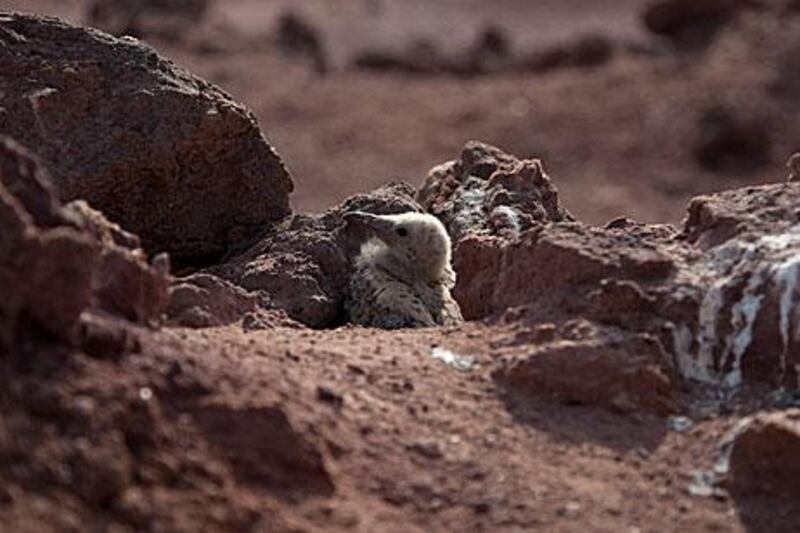SIR BU NAIR ISLAND // To pearl divers, it is known as the pearl-shaped island. Marine environmentalists call it turtle island. To Emirati poets it is the "tear-drop" island that fell into the waters of the Arabian Gulf.
These three descriptions are understandable, considering the island's unusual shape. Most of it is round, stretching four kilometres across with an additional kilometre of land extending out like a tail.
The island offers a wealth of untouched nature: behind a row of small sandcastle-like structures built by shell crabs to lure mates, lay a series of tractor-like prints. These are the tracks left behind by the hundreds of turtles that head onshore to dig nests and lay eggs where they themselves were born. The nests are carefully marked by sticks placed by Emirates Marine Environmental Group (Emeg), which has been monitoring turtles on the island for the past two years. There have been 335 turtle nests dug in the last two months alone.
For Major Ali al Suweidi, the group's president, not only does Sir Bu Nair look like a turtle from above - it serves as a true haven for the creatures.
Last year 324 endangered hawksbill turtle nests were recorded on the island, in addition to two green turtle nests, providing the first contemporary evidence of green turtle nesting in the UAE.
"These findings establish Sir Bu Nair as the most important turtle nesting site for hawksbills in the UAE and one of the most important turtle islands in the Arabian Gulf as a whole," said Major al Suweidi. "Turtles have been coming here for at least a thousand years, and only now we have discovered this."
Besides its importance to turtles, the island has produced discoveries of six new coral species and four rare reef fish species, including the mischievous yellow or citron clown goby fish. The Redcoat squirrelfish, previously unrecorded in the Gulf, was discovered here as well.
Sir Bu Nair's marine life is just one of its natural treasures. Colonies of birds, such as the Sooty gull and the Bridled tern, nest and live on the island alongside gazelles and hedgehogs.
Dozens of fluffy white and grey baby birds were peeking through cracks in the small cliff-top ledges and rocky outcrops, waiting for their mothers to fly over with bits of fish. Emeg has been capturing and putting down feral cats to protect the bird colonies, which include more than a 1,000 pairs of Sooty gulls nesting on the island.
Even the soil is distinct, offered in seven colours ranging from deep red to bright yellow, depending on its mineral and metal contents.
Before it was made into a nature reserve in 2000 by the Ruler of Sharjah, Dr Sheikh Sultan bin Mohammed al Qassimi, Sir Bu Nair produced many stories. In the late 1800s and early 1900s, it was an important base for pearl divers, who would camp out on the island as they dived and fished for pearls. The single well on the island was believed to have healing powers, and would be protected fiercely by the pearl divers.
One of the spots on the island, known as Abu Fenjan, or Abu Fenyan, is named after an Arabic coffee cup that was dropped by a pearl diver in that spot.
One of the theories behind the name of the island, Sir Bu Nair, goes back to an old legend about a pearl diver who lost his mind and started wailing like a donkey. Nair refers to the sound made by donkeys, a similar sound some say can be heard on the island during the mix of certain winds.
Parts of the island were also once mined for iron ore and sulphur, but the ventures were later abandoned when they proved too costly.
With the onset of the Gulf War in 1990, parts of the island were turned into a military base.
Today, the island is part natural sanctuary, part military and part police. Radars and telecommunication towers there run on solar energy.
A single wooden cottage, belonging to the Bin Hada family in al Khan area of Sharjah, remains standing on the island. For the 40 years before it was turned into a reserve, each autumn the male members of the family would use the cottage while they caught wild falcons and hawks that migrated there. They would then sell the birds on for falconry.
Even though it is 112km from Sharjah and just 80km from Abu Dhabi the island belongs to Sharjah, which must approve any visits through its Environment and Protected Areas Authority.
Sharjah has based a special police force on the island, which remains on the lookout for unannounced guests and poachers.
There are dhow races allowed each year near the island, but they too remain under strict supervision by the authorities.
The fierce spirit of protection is reflected in the police force's motto, which is framed and hangs in their station: "We take pride in defending the island, and everything in it and around it."
One of the island's police officers, who spoke on the condition of anonymity, has an extra, unofficial duty of care: he regularly saves eggs that have rolled from their nests and on to the road before they get crushed.
"You can sail, yes," he said.
"But don't come near our turtles."






